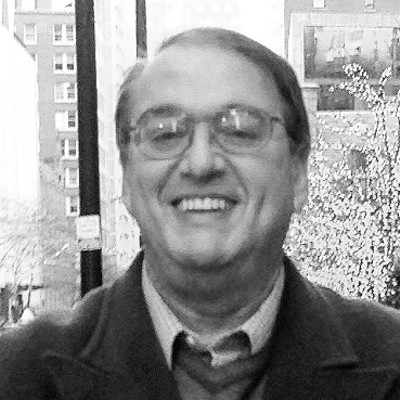EXHIBIT:"Four Between Form and Non-form," paintings by Dorothy Martinez, stone carvings by Robert S. Babcock, woven constructions by Anne Wallis-Bull and a site-specific glass installation by Ethan Bond-Watts. Flynndog, Burlington. Through October.
ARTWORK:"Web Spinner" by Anne Wallis-Bull
Abstraction seems to have become a dirty word in the contemporary art world, as conceptual narratives fueled by irony are all the rage. Most of the recent Firehouse Gallery shows are cases in point, and numerous traveling exhibitions, such the Hood Museum's recent "Past in Reverse: Contemporary Art of East Asia," confirm that the new paradigm is not just a local phenomenon.
The Flynndog's current show, "Four Between Line and Form," ignores the bandwagon with four powerful abstractionists working in different media. Each presents enough work to confirm their common grounding in mid-20th-century modernism.
Robert Babcock presents 15 tabletop sculptures that combine the curvaceous lines of human forms with holes of negative space. His black soapstone "Zeus," which measures 16-by-14-by-12 inches, echoes Inuit carving in both material and bulky mass. Its vertical composition is dominated by smooth ovals on one surface and soft-edged rectangles on the other. His slightly larger, horizontally oriented "Infiniment de l'Homme" showcases the grain of creamy, pinkish-white alabaster and brings out the material's warmth with a cherrywood rectangular base. Despite their physical weightiness, Babcock's pieces convey lightness.
Waitsfield sculptor Anne Wallis-Bull weaves sticks and other intriguing wood products gathered from Vermont and Florida into large-scale abstract nests and basket-like constructions of amazing complexity. "Web Spinner" is a dramatic, 3-by-4-foot disc form that calls to mind a warped vinyl record. A shock of red is woven into the disc at 7 o'clock.
"Papoose" is a child-sized, twisted basket made from the same materials as "Web Spinner." Wallis-Bull built two ovoid openings into the form and placed a craggy stick through the basket's interior. It vaguely resembles an oriole's nest.
Dorothy Martinez is well known locally for creating vibrant color fields smeared with equally bright swaths. Magentas, lilac and lime green are among her dominant hues in most of the 32 undated canvasses here. The 24-by-24-inch "Ornament" utilizes that palette with feathery brushwork that scumbles green over red-orange on a left-leaning, diagonal axis. Martinez activates the edges of her composition with dark patches along the right side and in the upper left corner.
A few monochromatic pieces make surprise appearances in Martinez's collection. "Pandora Punished" is a 35-by-35-inch acrylic of white mixed with hints of ruddy burnt sienna. An indistinct figure looms in the lower left corner, ghostlike in a pale mist. If this marks a new direction in the painter's evolving career, it will be interesting to see what happens next.
"Kyklon" by glass artist Ethan Bond-Watts is a suspended, floor-to-ceiling tornado form, about 15 feet high, consisting of concentric blue glass curves hung from gossamer filaments. Bond-Watts began his career as an apprentice to renowned glass artist Alan Goldfarb of Burlington, and has also studied in Venice and Japan. The word "kyklon" is Greek for cycles or coils, and is used in meteorology to describe cyclonic action - as Bond-Watts' work gracefully captures.
Although Ben Shahn was a leading 20th-century social-realist painter, he had a keen enough grasp of abstraction to say, "To abstract is to draw out the essence of a matter. To abstract in art is to separate certain fundamentals from irrelevant material which surrounds them." The Greek Parthenon was based on those principles. Should the witticisms of contemporary art someday grow thin to the point of irrelevancy, let's hope the timeless formalism of abstraction regains stature in the cultural debate.









Comments
Comments are closed.
From 2014-2020, Seven Days allowed readers to comment on all stories posted on our website. While we've appreciated the suggestions and insights, right now Seven Days is prioritizing our core mission — producing high-quality, responsible local journalism — over moderating online debates between readers.
To criticize, correct or praise our reporting, please send us a letter to the editor or send us a tip. We’ll check it out and report the results.
Online comments may return when we have better tech tools for managing them. Thanks for reading.